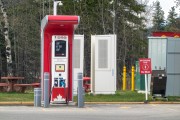Canada is entering a new era in clean transportation. The adoption of zero-emission road freight has been picking up and a close read of market trends shows that, overall, growth in the electrification of medium- and heavy-duty vehicles (MHDVs) will continue and even accelerate in the relatively near future. Bloomberg NEF estimates deliveries of commercial electric vehicles (EVs) will double from 500,000 in 2023 to 1 million in 2024.
Charging stations for electric MHDVs – which will constitute the majority of zero-emission models on the road – and refuelling stations for hydrogen fuel cell vehicles will need to align with uptake. Six formidable (although not insurmountable) challenges are slowing the pace of deployment:
1. The knowledge gap
A recent survey conducted by Natural Resources Canada revealed that 40% of fleet owners/operators in Canada do not know how an electric vehicle is “fuelled.” This knowledge gap surfaced in engagement sessions that the Pembina Institute hosted to solicit feedback from stakeholders in the MHDV sector and is corroborated by other surveys as well. A recent North American survey revealed that 44% of small fleet operators and 60% of large fleet operators cited "unfamiliarity with technology" as a key impediment to switching to electric MHDVs. Hesitancy in uptake extends to infrastructure installation and is effectively a barrier to charger deployment.
The knowledge gap is compounded by the absence of publicly available information covering the basics about zero-emission MHDVs, including market availability, operating requirements, and how to connect electric fleets to the grid. A survey commissioned by the Ontario Energy Board in November 2022, revealed that most EV charging service providers cited a lack of clarity on cost sharing formulas, on roles/responsibilities for EV infrastructure development, and on planning advice about charging installation. In combination, the dearth of information available to fleet owners and operators served as significant barriers to uptake in either electric vehicles or their charging requirements.
2. The bottom line
On-site installation costs vary widely, ranging from $65,000 for an overnight charger (with a power output of 50 kW, sufficient for one truck to charge overnight) to $1 million for fast chargers (1 MW power output to charge multiple vehicles). For small fleet owners (defined as owning one or two trucks), these costs can be prohibitive. Nearly half (40%) of Canada-based trucking fleets are, in fact, only a single truck; 90% of fleet owners in Canada operate less than 10 trucks.
Many fleet operators rely on street parking and will therefore depend on public charging infrastructure to operate an electric truck. The Natural Resources Canada survey noted that 77% of small fleet owners identified the absence of public infrastructure as a roadblock to electric vehicle adoption. Tellingly, more than half (68%) of owners of larger fleets also cited the lack of public infrastructure as a barrier.
3. Electricity rates
Responding to the 2022 Natural Resources Canada survey, 94% of fleet operators identified fuel costs (or charging costs in the case of electric vehicles) as an important determinant in choosing which vehicle to purchase. As with the cost of gas or diesel, high electricity rates also influence purchasing decisions, potentially slowing or even preventing rapid adoption of electric MHDVs and charger deployment.
In general, electricity rates are based on a customer’s energy consumption at times of peak demand, i.e., the maximum amount of power a customer uses for a brief period over the course of 24 hours. Because of the formula used to determine electricity rates, EV fleet owners are charged at the higher rates that are applied to commercial consumers, even though, on average, early-stage EV fleet operators draw relatively much less power than the typical commercial customer.
During our stakeholder meetings, fleet operators and EV charging service providers consistently cited electricity rates as a key factor in weakening the business case for owning electric vehicles and installing private charging infrastructure. A report commissioned by the Ontario Energy Board came to the same conclusion when respondents to a 2022 survey “unanimously agreed they were concerned with the impact of demand charges on future EV supply equipment deployment.” As a means of addressing this concern, British Columbia recently started offering discounts on electricity rates for fleets considering EV adoption.
4. It’s complicated
The complexity of the regulatory process is a concern that is frequently raised among stakeholders, including service providers. Electricity Canada recently published a study in which electricity industry representatives noted that approvals processes are overly cumbersome and require both duplication of effort and numerous rounds from multiple agencies. The unwieldy process has caused delays in integrating EVs to the grid. In Ontario, the Minister of Energy directed the Ontario Energy Board to take steps to reduce the number and cost of regulatory burdens by the end of March 30, 2026.
5. Little or no standardization
At a Pembina Institute-hosted webinar in August 2023, representatives from several utilities identified the absence of uniformity or standardization among chargers and charging stations as a significant barrier to deployment. In a recent interview, the CEO of the Ontario Energy Board toldElectric Autonomy, “In Ontario alone, there are about 60 local distribution companies. This translates into 60 different engineering standards, work methods, costs and timelines for providing power to electric MHDVs. It creates a complex energy sector.” He also agreed that the absence of a singular charging standard has caused widespread reluctance among owners to increase the size of their fleets by adding electric models.
Conversely, implementing standardization for EV charging hardware, software, installation and operating protocols would reduce compliance complexities, catalyze economies of scale, lower production costs for manufacturers of both trucks and chargers, and greatly improve interoperability.
6. Grid capacity
Should policies encouraging rapid adoption of electric vehicles (both passenger and MHDVs) be successful, the demand for electricity in Canada is predicted to increase by 47% between 2021 and 2050. The Independent Electricity System Operator in Ontario estimates that grid capacity in Ontario will need to more than double to meet the demand triggered by decarbonization efforts. Ensuring that the grid is ready for a rapid transition to battery-powered vehicles will require upgrades to local electricity distribution networks before installing charging stations. Local distribution investments are costly and time consuming, causing bottlenecks in infrastructure build out.
The takeaway
In short, the transition from a road freight system entirely dependent on fossil fuels to one that is primarily driven by battery power will include more than a few bumps in along the way. Even so, Canada has entered a new, electric phase in the automotive industry and representatives from private and public sectors are coming together to advance solutions to these main challenges.
 To that end, the Pembina Institute recently launched a project, supported by FedEx, mapping out the charging and energy needs for fleets in the Greater Toronto and Hamilton Area. We are also hosting a full-day workshop where industry leaders, utility representatives and fleet owners will convene to forge pathways to an emission-free transport system, where the outcome can be measured in a reduction in emissions, improvements in air quality, and positive overall health outcomes.
To that end, the Pembina Institute recently launched a project, supported by FedEx, mapping out the charging and energy needs for fleets in the Greater Toronto and Hamilton Area. We are also hosting a full-day workshop where industry leaders, utility representatives and fleet owners will convene to forge pathways to an emission-free transport system, where the outcome can be measured in a reduction in emissions, improvements in air quality, and positive overall health outcomes.







